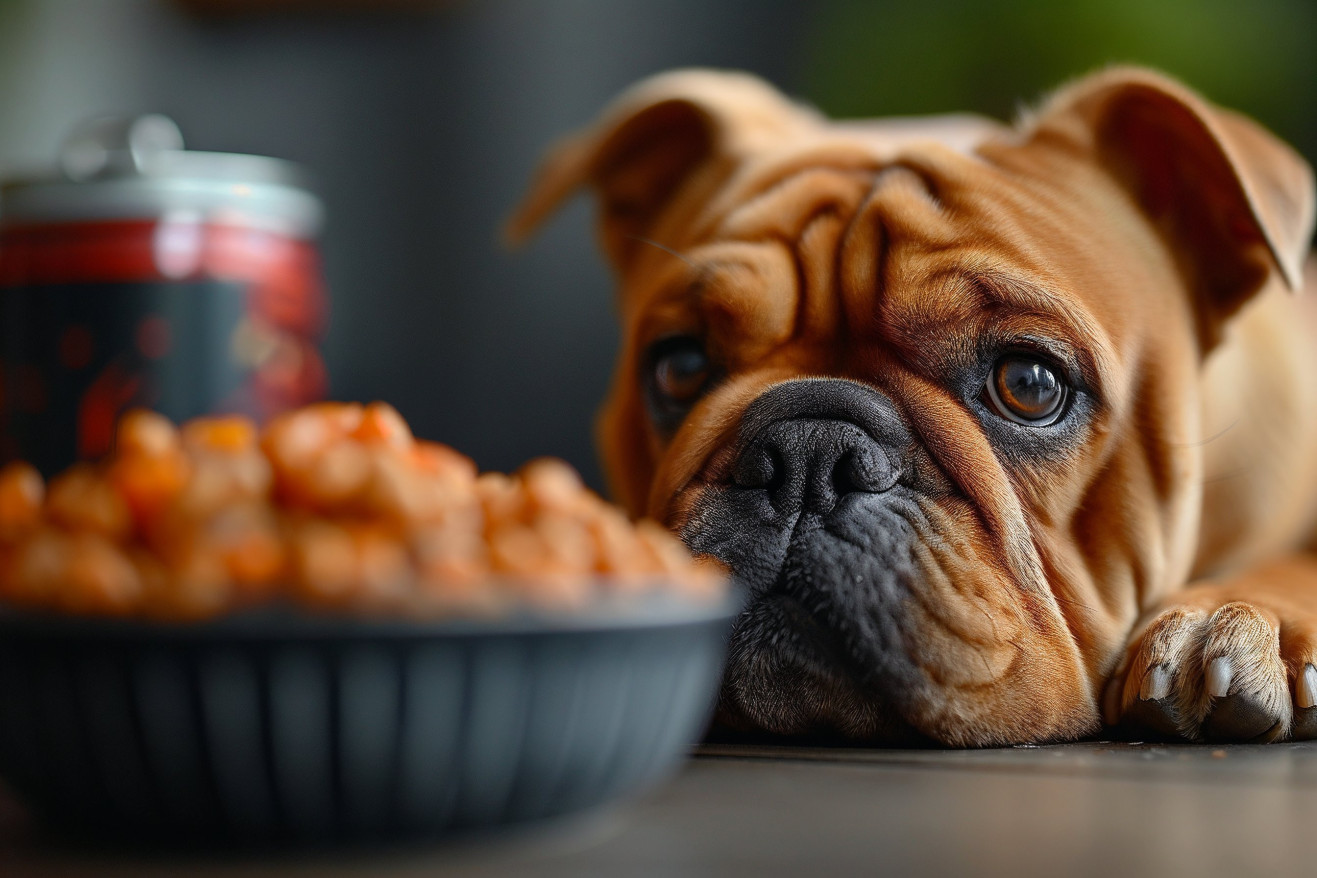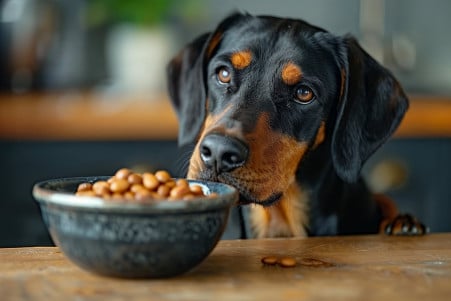Can Dogs Eat Refried Beans? A Nutritional Safety Guide
8 February 2024 • Updated 7 February 2024

Refried beans are a staple in many human diets, but their nutritional content may make you wonder if they’re safe for dogs. Dogs cannot eat refried beans because they are high in salt, often contain spices like onion and garlic which are toxic to dogs, and are high in fat. While dogs can eat plain cooked beans in moderation, the ingredients in refried beans can be harmful to dogs.
In this investigation, we will review veterinary science, canine nutrition, and toxicology research to better understand the dietary needs of dogs. We will look at the nutritional content of beans, how they are prepared, and the effects of spices and other additives on dog nutrition.
To make sure you are feeding your dog responsibly, we will concentrate on research-backed information to help you understand what you should and shouldn’t feed your dog. This will help you make the best dietary decisions for your dog.
Can dogs eat refried beans?
How to Avoid the Risks of Feeding Dogs Refried Beans
Feeding dogs refried beans can result in a number of health issues. One of the most serious is the high sodium content that is often present in these products, which can lead to salt toxicosis, a condition that occurs when there is too much sodium in the blood. The American College of Veterinary Pharmacists reports that this can be life-threatening for dogs, and symptoms of salt toxicosis include vomiting, diarrhea, and seizures.
In addition, the spices that are often added to refried beans, such as onion and garlic, are toxic to dogs. VCA Animal Hospitals notes that these alliums can cause gastroenteritis and oxidative damage to red blood cells, which can lead to anemia. The disulfides and thiosulfates in these plants are toxic to dogs whether they are eaten raw or cooked.
The added fats in refried beans can also be problematic for dogs, leading to gastrointestinal upset and long-term health problems associated with obesity.
The PDSA recommends that dog owners take their pet to the vet immediately if they suspect allium poisoning, which can cause symptoms like a loss of appetite and lethargy. Dog owners can help protect their pet’s health by learning about these risks and making sure to avoid them when feeding their dogs.
The Best Beans for Your Dog’s Diet
Not all beans are created equal when it comes to the health of your dog. Pinto and black beans are two of the best options for your furry friend when prepared properly. According to DogTime, pinto beans are a great source of B vitamins, iron, potassium, and protein. They also contain fiber for digestive health and antioxidants that can help with weight management.
Meanwhile, Wild Earth explains that black beans are high in protein and low in fat, and they also have been shown to help suppress appetite, which can help with weight management. Black beans are also high in manganese, which is important for brain health and can help boost metabolism.
That said, it’s important to make sure that you prepare the beans properly. Both pinto and black beans need to be soaked and then cooked to remove toxins and make them easier for dogs to digest. WagWalking warns against feeding dogs raw beans because of the risk of toxicity and also warns against feeding dogs toxic ingredients.
Make sure you keep the portions of beans reasonable—usually a tablespoon or two per meal—and make sure that you don’t exceed ten percent of the dog’s total diet. This will help ensure that the beans are a supplement to your dog’s diet rather than replacing important proteins. Also, make sure that you avoid canned beans that are high in sodium and preservatives and stick to home-cooked beans for your dog.
How to Create a Diet Plan for Your Dog
Just like people, dogs have specific nutritional requirements that need to be met in order to maintain good health. PetMD explains that a healthy dog diet should include protein, fat, carbohydrates, vitamins, and minerals. Protein is important for tissue repair and growth, fat is an energy source and helps maintain healthy skin and coat, and carbohydrates provide quick energy and dietary fiber.
That said, it’s important to make sure that your dog’s diet is well-balanced. VCA Animal Hospitals explains that while dogs’ digestive systems have evolved to eat a diet that includes some plant-based foods, they still need a carefully balanced diet that includes all the essential nutrients.
Overfeeding and feeding dogs foods that aren’t appropriate for their species can be dangerous. For example, several human foods, including chocolate, caffeine, grapes, and onions, are toxic to dogs and should never be given to them.
It’s also important to note that dogs have different nutritional needs than people. For example, while people often use a variety of spices to flavor their food, these can be toxic to dogs. WebMD notes that it’s important to make any significant changes to your dog’s diet with the help of a professional.
This way, your vet can make sure that any new foods you’re adding to your dog’s diet, including the occasional bean, will help, rather than hurt, their health.
How to Transition Your Dog to New Foods
To avoid stomach upset, it’s important to introduce new foods to your dog’s diet slowly. The American Kennel Club recommends a transition period of 5 to 7 days, with the first day consisting of 25% new food and 75% old food.
From there, gradually increase the amount of new food in the mixture. If your dog experiences vomiting, diarrhea, or a loss of appetite, it may be a sign that they are not responding well to the new food.
While PetMD emphasizes the benefits of rotational feeding, or feeding your dog a variety of different complete and balanced foods, to ensure a more diverse diet, it also notes that this method may not be suitable for dogs with sensitive stomachs. If your dog has a negative reaction to rotational feeding, go back to their regular diet and consult your vet.
It’s important to pay attention to how your dog responds to new foods. As Hill’s Pet notes, when transitioning diets, it’s important to keep an eye on your dog’s food consumption and monitor any changes in their behavior or stool quality, which can be an indication of how well they are adjusting.
If you’re ever unsure, consult your vet, who can provide personalized advice based on your dog’s unique dietary requirements. By paying attention to these factors, you can ensure that your pet has a safe and successful transition to new foods.
Final Thoughts: Making Sure Your Dog’s Diet Is Healthy
In this article, we’ve driven home one important dietary warning for dog owners: don’t feed dogs refried beans. We’ve gone over the health concerns that come with feeding dogs refried beans, including the dangers of high sodium, toxic spices, and high levels of fats, all of which can lead to short-term and long-term health issues for our dogs.
At the same time, we’ve also pointed out that some beans can be good for dogs when they are prepared in the right way and given in the right amounts.
This is why it’s so important to make sure that a dog’s diet is well-balanced and meets their specific nutritional needs while also taking into account the dietary limitations that come with being a dog and the potential toxicity of some foods that are safe for humans.
In the end, it’s important to once again stress the importance of responsible pet feeding. We need to make sure that we are making dietary choices that are in the best interest of our dogs and that are backed up by veterinary science and toxicology.
For personalized dietary recommendations, always talk to a vet who knows your dog and their needs. By doing this, we can make sure that we are providing our dogs with the best care and nutrition.


